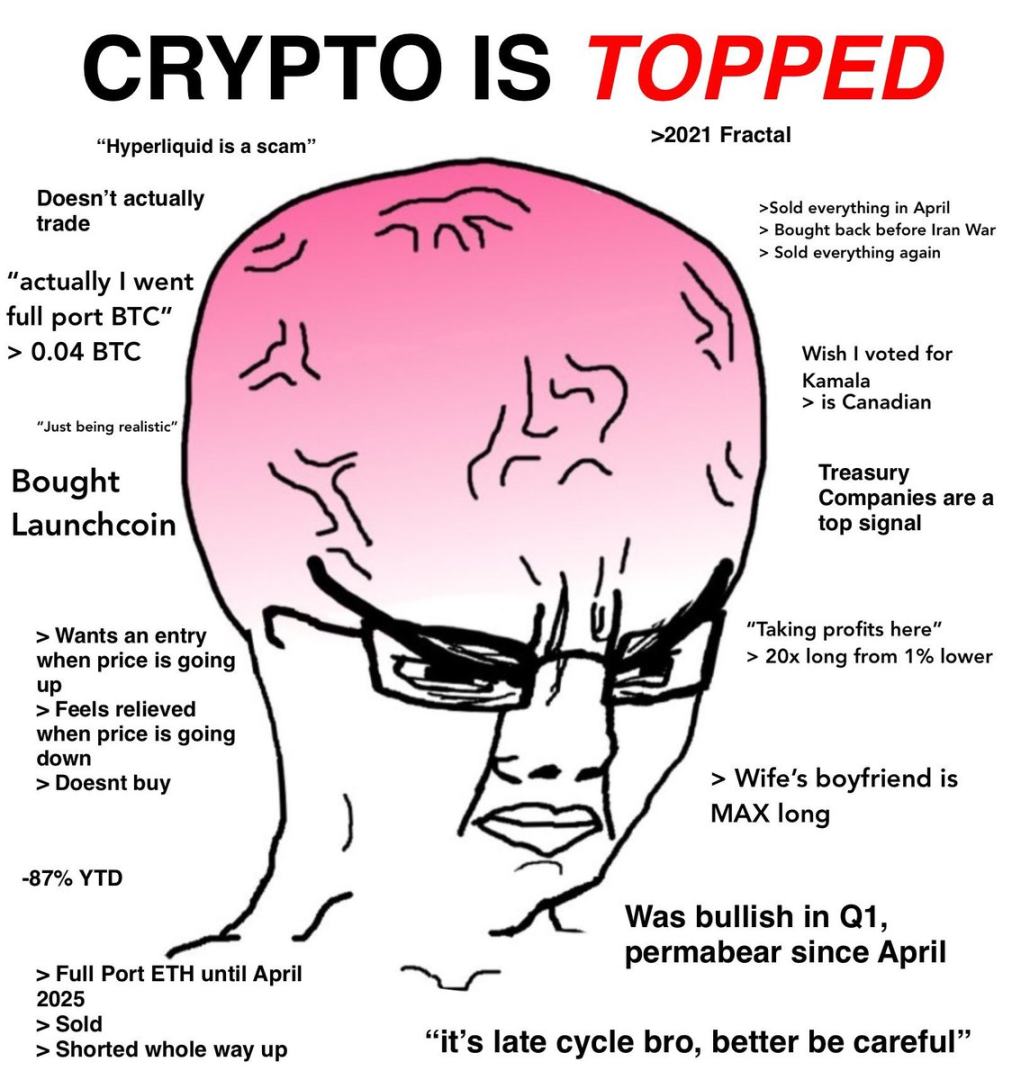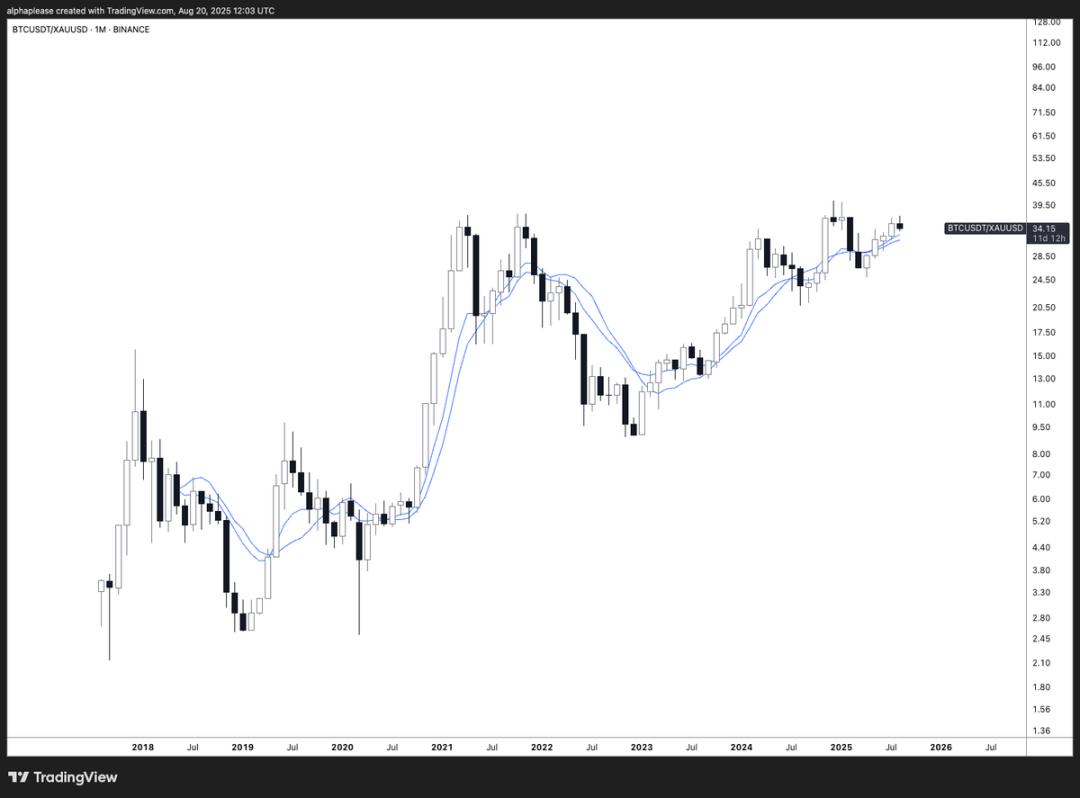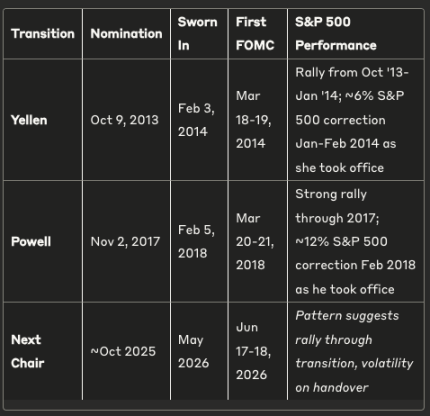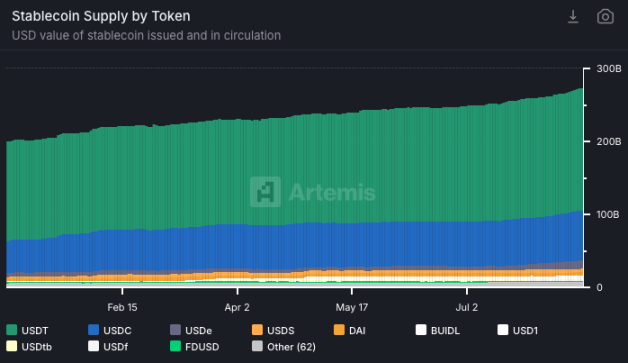Written by: Aylo
Translated by: Saoirse, Foresight News
Let's start by pondering a question: do you think you can accurately sell at the market's peak? The answer is quite clear — almost no one can, including myself, and there's no need to force it. The formation of a cycle peak has a characteristic: it can appear quickly within a short time frame, but it is difficult to accurately identify before it manifests in higher time frames (HTFs).
Day traders who focus on short-term trading may catch some signals, but they have already called out "the peak has arrived" multiple times, and after so many instances, these judgments naturally lose their significance — after all, they do not pay attention to the macro market background.

Therefore, regarding market cycles, you need to observe and judge for yourself to make suitable financial decisions. After all, the market changes rapidly, and my views will adjust with new data, for your reference only.
Arguments Supporting the "Four-Year Cycle Peak"
Pattern Recognition Arguments:
Looking back at historical charts, a clear pattern cannot be ignored: December 2013, December 2017, and November 2021 (all marked cycle peaks). The consistency of the four-year cycle is significant, and market patterns often persist until they are broken by fundamental changes.

Reasons This Pattern May Continue:
- Deeply Rooted Psychology: The four-year cycle is deeply embedded in the consciousness of cryptocurrency market participants;
- Self-Fulfilling Prophecy: Widespread awareness of the cycle may trigger coordinated selling pressure, compounded by hidden leverage in the system (such as DATs);
- Halving Correlation: Bitcoin halving can trigger supply shocks, and historically, peaks usually occur 12-18 months after halving (though in this cycle, it feels more like a market narrative);
- Occam's Razor Principle: The simplest explanation is often the closest to the truth — why complicate a pattern that has been validated three times?
We are clearly no longer in the early stages of this cycle — Bitcoin has risen significantly since its bottom. According to this pattern, we should be approaching the peak range.
Arguments Against the "Four-Year Cycle Peak" (2026 Cycle Continuation Theory)
Fundamental Change Arguments:
I pose a simple question: Will a cycle led by institutions really be completely consistent with the previous two cycles led by retail investors?
I generally agree that the market has cyclical characteristics, so I won't talk about a "super cycle," but I believe cycles may be lengthened or shortened due to other factors.
Reasons This Cycle May Be Different:
1. Differences in Behavior Patterns Between Institutions and Retail Investors
- The flow of funds from spot ETFs and traditional exchanges has created a new liquidity pattern;
- Institutional profit-taking is more stable and does not easily trigger panic selling like retail investors;
2. Traditional Indicators May Fail
- We have many cycle analysis tools (such as NVT, MVRV, etc.), but their historical data ranges are based on retail-led markets;
- Institutional participation fundamentally changes the definition of "overextension";
- When priced in gold, Bitcoin's current price has not even exceeded the previous cycle's peak — far from bubble territory;

3. Complete Transformation of the Regulatory Environment
- The regulatory environment for this cycle is vastly different; the U.S. and SEC are more accepting of cryptocurrencies, forming a clear framework for institutional participation;
- The end of previous cycles was partly due to regulatory shocks (such as the crackdown on ICOs in 2018);
- The risk of a systematic, sudden end to the cycle has significantly decreased;
4. Macroeconomic and Federal Reserve Dynamics
- Federal Reserve Chairman Powell's term will end in May 2026, and Trump may announce his successor at the end of 2025;
- The dynamics of the "shadow Federal Reserve chairman" weaken the effectiveness of current policies, and if the market expects Trump to nominate a dovish chairman, it may trigger early buying pressure;
- The first FOMC meeting of the new Federal Reserve chairman is scheduled for June 17-18, 2026 — potentially a market catalyst;
- The transition period may maintain a "Goldilocks environment" (an ideal state where the economy is neither too hot nor too cold).
_ (Note: "Goldilocks environment" is a common term in financial markets, derived from the concept of "not too hot, not too cold, just right" in the fairy tale "Goldilocks and the Three Bears." It means that during the transition period, economic and policy conditions may remain stable, providing support for continued market growth.)_
Historical Patterns of Federal Reserve Chair Transitions: Looking back at past transitions, a clear pattern emerges:

Both transitions exhibited the same sequence — nomination news triggered market rallies, and the upward momentum continued until the transition was completed, but the S&P 500 index would precisely pull back when the new chairman took office.
When Yellen took over, the S&P 500 fell about 6% in January-February 2014; when Powell took over, the index pulled back about 12% in February 2018. This indicates that after Trump announces his nomination at the end of 2025, the bull market may continue until the transition is completed, while volatility is likely to occur around the May-June 2026 transition — potentially coinciding with the cycle peak timing.
5. Changes in Market Structure
- Concerns about currency devaluation have created new demand drivers, no longer limited to shifts in risk appetite;
- The market capitalization of stablecoins can serve as a leading indicator — currently still growing (this is our "dry powder" indicator);

- The sources of demand for Bitcoin are more diversified than in previous cycles: ETFs, DATs, pension funds, etc.
What Factors Could Lead to an Early End of the Cycle and a Repetition of the Four-Year Cycle?
DAT Leverage Risk: I believe the main bearish factor is that DAT companies may close positions faster than expected. Large-scale forced selling could crush buyers and change the market structure. However, losing buying demand (mNAVs dropping to 1) is different from becoming a forced seller that triggers a "crash."
Nevertheless, the loss of purchasing power from major DATs is clearly significant. Many speculate that this situation has already occurred — the mNAVs of Strategy and major ETH DAT companies have dropped significantly. I am not ignoring this, and you should pay close attention as well.
Macroeconomic Risks: A resurgence of inflation is a real macro risk, but there are currently no signs. Cryptocurrencies are now highly correlated with the macro economy, and we are still in a "Goldilocks environment."
Missing Elements for a Cycle Peak
Market euphoria has not yet appeared:
- The market has not yet escaped the "wall of worry" — every 5% pullback triggers speculation about a cycle peak (this has lasted for 18 months);

- There has not been sustained euphoria, nor is there consensus in the market about subsequent rises;
- There are no characteristics of a peak such as "a surge followed by a crash" (though this is not a necessary characteristic).
If there is a significant rise in cryptocurrencies later this year, and the gains significantly outperform the stock market, this "surge followed by a crash" signal may indicate that the peak for cryptocurrencies is far earlier than the business cycle that may extend to 2026.
Stablecoin Leading Indicator
A highly valuable indicator: the growth of stablecoin market capitalization.
In traditional finance, the growth of M2 money supply often precedes asset bubbles. In the cryptocurrency market, the role of stablecoin market capitalization is similar — representing the total amount of "dollars" available within the crypto ecosystem.
Major cycle peaks often coincide with a stagnation in stablecoin supply 3-6 months prior. As long as stablecoin supply continues to grow significantly, the market may still have upward momentum.
My Current View
To be frank, based on current observations, I believe there will not be a major cycle peak before 2026 (this view may change at any time due to new developments).
The historical data points for the four-year cycle are limited (only three times), and institutional participation is a fundamental change in market structure. Just the dynamic of the Federal Reserve chair transition could extend the "Goldilocks environment" until 2025 — this is particularly important, especially given the unprecedented tight correlation between cryptocurrencies and the macro economy.
In this cycle, cryptocurrency market participants have a deeper understanding of the four-year cycle, which makes me feel that the outcome may be slightly different. When has the public's judgment ever been completely correct?
Will everyone sell according to the four-year cycle pattern and then exit completely?

However, I also acknowledge that the consistency of the four-year cycle pattern is significant, and market patterns often persist until they are broken. The public's awareness of the cycle may also become a self-fulfilling prophecy that leads to its end.
As Bitcoin's market cap share declines, I will continue to gradually take profits on those overbought altcoins; but I will hold onto Bitcoin because I believe it will reach new highs in 2026. It is important to note that regardless of the overall market cycle, the altcoins you hold may peak at any time.
Final Thoughts
The four-year cycle pattern is the strongest argument supporting a peak in 2025 — it has been validated three times, and simplicity often prevails. However, changes in market structure led by institutions, the dynamics of the Federal Reserve transition, and the absence of euphoric signals all suggest that this cycle may extend into 2026.
Conditions may change dramatically in the coming months, so there is no need to be overly stubborn in your views.
Regardless, accept that you cannot accurately sell at the peak and develop a systematic exit strategy.
The right position is one that allows you to sleep well at night. If you have already made substantial profits, "selling too early" is perfectly fine.
免责声明:本文章仅代表作者个人观点,不代表本平台的立场和观点。本文章仅供信息分享,不构成对任何人的任何投资建议。用户与作者之间的任何争议,与本平台无关。如网页中刊载的文章或图片涉及侵权,请提供相关的权利证明和身份证明发送邮件到support@aicoin.com,本平台相关工作人员将会进行核查。




